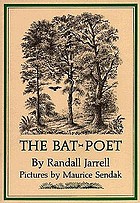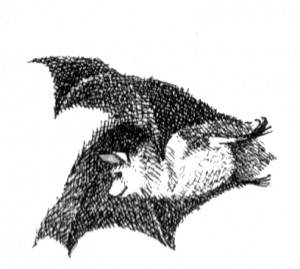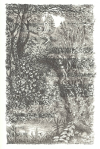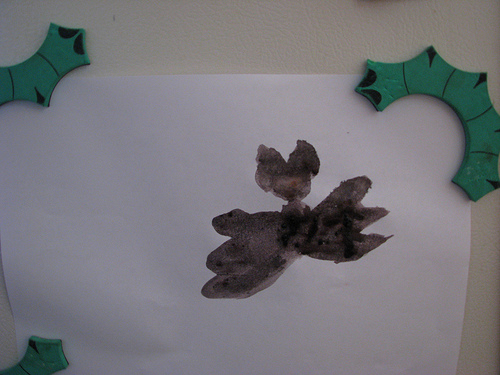Bats are a much-maligned animal. Long thought of as creepy or evil or diseased, a closer look reveals that the wide variety of bat species also possess an amazing array of attributes and perform all sorts of vital ecological roles: from pollinating bananas and mangoes to eating so many insects every night that they save [...]
Viewing: Blog Posts Tagged with: Randall Jarrell, Most Recent at Top [Help]
Results 1 - 5 of 5
Blog: PowellsBooks.BLOG (Login to Add to MyJacketFlap)
JacketFlap tags: Francesca Lia Block, Lists, Biology, Brian Lies, Janell Cannon, Diane Ackerman, Randall Jarrell, Nature Studies, Frank Herbert, Bill Schutt, Jack Couffer, Thomas H. Kunz, Zachary Thomas Dodson, Add a tag
Blog: So Many Books (Login to Add to MyJacketFlap)
JacketFlap tags: Children's Books, Books, Reviews, Randall Jarrell, Add a tag
 I don’t often read children’s books, I don’t have children of my own nor do I spend time with people who have children. However, when Carl Phillips in The Art of Daring discusses a few poems by Randall Jarrell and mentioned he had written a children’s book called The Bat-Poet, well, I had to check it out. My marvelous public library had a copy and I requested it immediately. Oh happy day when it arrived and I discovered it had illustrations by Maurice Sendak!
I don’t often read children’s books, I don’t have children of my own nor do I spend time with people who have children. However, when Carl Phillips in The Art of Daring discusses a few poems by Randall Jarrell and mentioned he had written a children’s book called The Bat-Poet, well, I had to check it out. My marvelous public library had a copy and I requested it immediately. Oh happy day when it arrived and I discovered it had illustrations by Maurice Sendak!
First published in 1964, just a year before Jarrell died at the age of 51, this is a little book that will delight everyone no matter what age. It is the story of a little brown bat “the color of coffee with cream in it,” who spends his days sleeping upside down from the roof of a porch snuggled up with the other bats. One day the other bats move into the barn to sleep but the brown bat didn’t want to sleep elsewhere so he stays on the porch alone. And because he is alone without the warmth of his companions, he begins waking up during the day and noticing things.
Like the mockingbird. The mockingbird sings and sings and sings and can imitate other animals and sounds. The bat is enchanted. He tries to sing but quickly discovers that bats can’t, so decides instead to imitate the mockingbird’s words. And the bat composes a poem:
At dawn, the sun shines like a million moons
And all the shadows are as bright as moonlight.
The birds begin to sing with all their might.
The world awakens and forgets the night.
He is so pleased with himself he wants to share his poem and all he has learned about the
daytime with the other bats. But the other bats just can’t be bothered. The sun hurts their eyes. They are too tired. Bats aren’t supposed to be awake during the day.Disappointed, the little brown bat decides he will share one of his poems with the mockingbird. The mockingbird is so full of himself he has a hard time being impressed, but he does not completely discourage the brown bat’s poetic endeavors. So our little bat goes in search of a new audience and discovers the chipmunk. The chipmunk is at first afraid of the bat but eventually agrees to allow the bat to compose a poem about him and then return in a few days to recite it. Are you surprised to hear the chipmunk is delighted and becomes the bat’s best listener and cheerleader?
I won’t tell you more, you have to get a copy of this book and discover the rest of the story for yourself. It’s a lovely, gentle story about poetry, creativity, and being different. But it does not have a slick moral at the end that slaps you in the face. It is a story written by a poet after all. Don’t worry, our little brown bat doesn’t die, nor is he an outcast or anything like that. Winter comes and he does what brown bats do in winter, hibernates in the barn with the rest of the bats. But it is not a giving in to convention and giving up poetry either, because as out little bat falls asleep he is thinking of the poem he composed about bats that he plans on telling them all when they aren’t so sleepy.
Filed under: Books, Children's Books, Reviews Tagged: Randall Jarrell
Blog: Here in the Bonny Glen (Login to Add to MyJacketFlap)
JacketFlap tags: Randall Jarrell, The Bat-Poet, Poetry, poetry friday, Maurice Sendak, Add a tag
 The bat-poet remembers his earliest days:
The bat-poet remembers his earliest days:
…And then the mother dances through the night
Doubling and looping, soaring, somersaulting—
Her baby hangs on underneath.
All night, in happiness, she hunts and flies.
Her high sharp cries
Like shining needlepoints of sound
Go out into the night and, echoing back,
Tell her what they have touched.
She hears how far it is, how big it is,
Which way it’s going:
She lives by hearing.
More Poetry Friday posts: Wild Rose Reader
More Bat-Poet moments
Rose petal, rock, leaf, bat
Her bat mood
Blog: Here in the Bonny Glen (Login to Add to MyJacketFlap)
JacketFlap tags: books, Poetry, Randall Jarrell, The Bat-Poet, rillabooks, Add a tag
I knew Rilla was enjoying The Bat-Poet, but I didn’t realize how much until this afternoon, as we neared the end of the book. She turned to me with furrowed brow and said, “When we finish, will we be able to read it again?”
“You mean right away?”
“Yes.”
I told her sure we could, and she heaved a mighty sigh of relief.
I’ve noticed that the older girls can’t help but be drawn into the story if they pass through the room where Rilla and I are reading. It’s a soft and gentle tale, rather quiet, with velvety-rich language. Oh, I just love Randall Jarrell. His mockingbird and chipmunk have such personality, and the introspective, yearning bat is a kindred spirit—really. He composes poems. He longs to be able to pour forth a magical, uplifting song like the mockingbird’s, but he can’t sing. He finds himself fitting observations into words and phrases, lyrical and perceptive lines of poetry. But oh, how he doubts himself. The mockingbird’s cool, clinical analysis—“It was clever of you to have that last line two feet short”—leaves him bewildered and longing for an audience who is moved by his words. When, after hearing the bat’s poem about an owl, the chipmunk shivers and vows to go underground before dark from now on, the little bat is deeply gratified: he knows his words have had an impact.
His poems move and shiver me, too—
All day long the mockingbird has owned the yard.
As light first woke the world, the sparrows trooped
Onto the seedy lawn: the mockingbird
Chased them off shrieking. Hour by hour, fighting hard
To make the world his own, he swooped
On thrushes, thrashers, jays, and chickadees—
At noon he drove away a big black cat.
Now, in the moonlight, he sits here and sings.
A thrush is singing, then a thrasher, then a jay—
Then, all at once, a cat begins meowing.
A mockingbird can sound like anything.
He imitates the world he drove away
So well that for a minute, in the moonlight,
Which one’s the mockingbird? Which one’s the world?
I know that mockingbird.
I know that bat, too.
Add a CommentBlog: PaperTigers (Login to Add to MyJacketFlap)
JacketFlap tags: Snow White, Room to Read, Nancy Ekholm Burkett, Randall Jarrell, Add a tag
 It was a very adult literary festival in Beijing where attendees listened to authors while sipping single-malt Scotch and cigarette smoking wasn’t prohibited. So it came as a distinct surprise when in a discussion of Orientalism versus reality in contemporary fiction, the subject shifted to children’s literature.
It was a very adult literary festival in Beijing where attendees listened to authors while sipping single-malt Scotch and cigarette smoking wasn’t prohibited. So it came as a distinct surprise when in a discussion of Orientalism versus reality in contemporary fiction, the subject shifted to children’s literature.
Born in 1965, author Liu Hong’s childhood took place during the Cultural Revolution. As a teenager, after the death of Mao, she began to study English. The first book she read in English was Snow White, which she thought was beautiful, with its colored pictures printed on heavy paper; it was, she said, voluptuous and it turned her into a passionate reader of English literature.
English became her other world, her secret language. She kept a diary in English because her family couldn’t read it, and this became the currency of her thoughts and feelings. She moved on from Snow White to Wuthering Heights and years later was disappointed that in Yorkshire she did not get lost in the moors.
Liu Hong is now a best-selling author of four novels, all of which she wrote in English.
Who can predict what the effect of a beautiful, well-written children’s book can be? Although she didn’t specify which edition of Snow White made her a reader–and eventually a writer, Liu Hong could well have been influenced by Randall Jarrell and Nancy Ekholm Burkert’s Caldecott Honor award winner, which was published in 1973.
Who knows, when we donate to organizations– like Room to Read or Books for Laos– that make children’s books in English available overseas, what best-selling author of the future will be caught by the experience of reading in English and will go on to enrich other readers in years to come?




